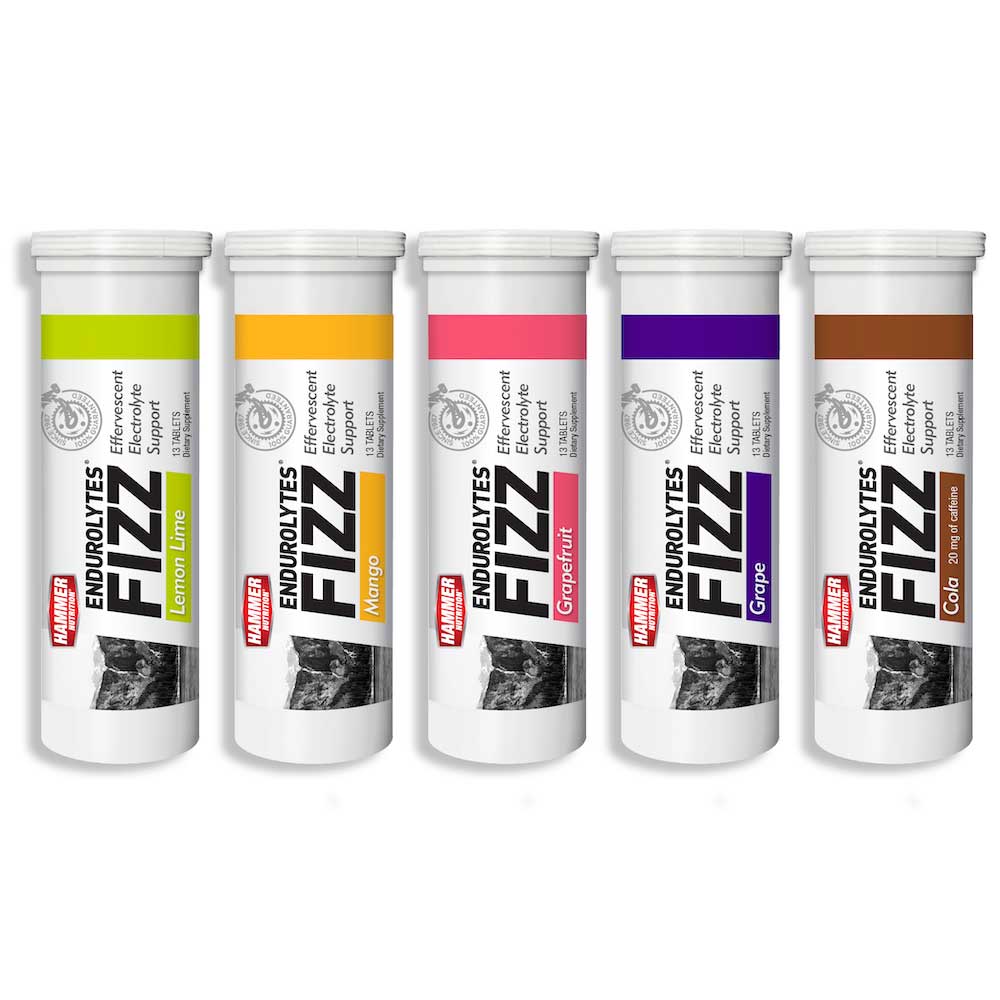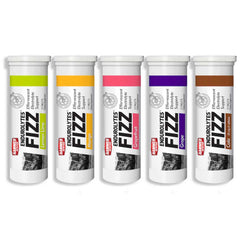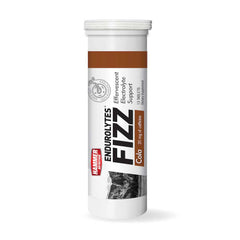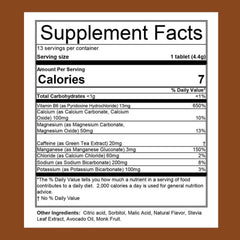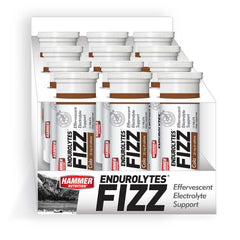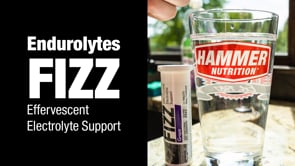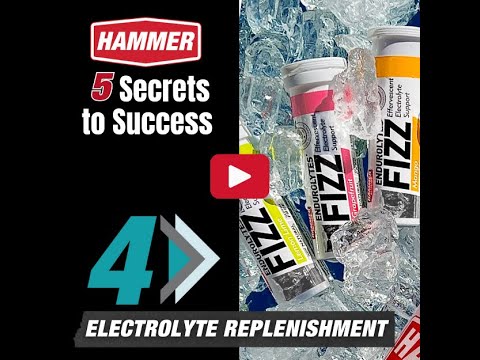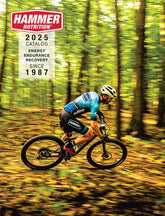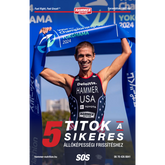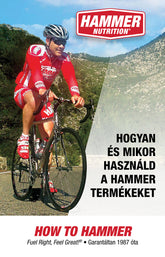Why do I need electrolytes?
Electrolytes are like the motor oil in your car: they don’t make the engine run, but they’re absolutely necessary to keep everything internally operating smoothly. Just as you wouldn’t wait for your engine to seize before you top off the oil, don’t wait to cramp up before you replenish electrolytes. Long before you cramp, your output will suffer from mineral depletion. The goal of electrolyte replenishment is smooth, uninterrupted, uncompromised performance. Without the proper levels of electrolytes, your body can’t carry out critical body functions such as muscle contractions, normal heart rhythms, and nerve impulses, all of which are critical for performance and health.
What’s the difference between HEED and Endurolytes or Endurolytes Fizz?
Every scoop of HEED contains 110 calories and about the same amount of electrolytes as found in one Endurolytes capsule or approximately one-half tablet of Endurolytes Fizz. Neither of these two electrolyte replenishment products are a calories source. Most athletes will fulfill all their calorie needs, as well as at least some of their electrolyte needs for an hour with one to two scoops of HEED in a water bottle. Heavier athletes and/or athletes competing in hot-weather conditions will oftentimes need additional electrolytic mineral support via additional Endurolytes capsules or Endurolytes Fizz tablets.
HEED - Calories + electrolytes
Endurolytes, Endurolytes Fizz - Electrolytes only
What are your thoughts on sweat tests?
Q: I recently did a sweat test, with the results showing that I need 1,000 mg or more of sodium per hour during my workouts and races. What are your thoughts?
A: While there may be some interesting information to derive from a sweat test, we at Hammer Nutrition are not a fan of them, mainly because that information is limited and only reflects a small part of the entire picture. Simply put, the results from a sweat test are not representative of what happens during prolonged bouts of exercise.
In a sweat test, the athlete rides a bike or runs on a treadmill in a controlled environment, with their sweat captured to determine fluid and electrolyte loss. That’s all fine, but how long is the test? Maybe an hour? That may be accurate in determining fluid and sweat loss during that first hour or so, but it’s not indicative of what will happen each hour following that initial test hour.
When we begin exercise, we generally lose a lot of fluid and electrolytes, especially salt (sodium chloride), in that first 30-60 minutes. That’s not unusual at all. The problem with going "all in" with sweat test results is that you're basically assuming that these losses are going to occur in the same amounts and volume hour after hour; you're not taking into account the many built-in mechanisms in the human body that regulate fluid and electrolyte use.
It's important to understand that we already begin exercise with massive, double-digit gram amounts of sodium already in our bodies. Once exercise commences, we usually lose a fair amount of fluid and sodium during that first hour or so. However, the human body, the marvelously designed machine that it is, recognizes this and a number of hormonal mechanisms that help monitor and regulate fluid and mineral loss (especially the latter, and particularly sodium) become actively engaged.
Regarding sodium loss, there is a hormone called aldosterone whose primary responsibility (in layman’s terms) is to monitor sodium levels in the body. And when aldosterone senses that sodium losses are becoming too great to maintain normal bodily functioning, it orchestrates a complex process by which sodium is recirculated back into the system via the kidneys. In doing so, aldosterone helps conserve our stores of sodium. Now, this recirculation/conservation process cannot take care of all our requirements hour after hour after hour; we need to supplement with electrolytes to work with aldosterone and help maintain adequate electrolyte status.
The mistake that many athletes commit is that they overdo it with the salt/sodium. They oftentimes look at these sweat tests and notice (for example) that perhaps 1-2 grams of sodium has been lost. NOTE: 1-2 grams of sodium equals 2.5 – 5.0 grams of salt (40% sodium, 60% chloride). That is a TON of salt! Forgetting that the body will not automatically and repeatedly lose this amount hour after hour after hour—and not taking into account aldosterone’s actions to monitor, recirculate, and thus conserve sodium stores—athletes will start consuming 1-2 grams of sodium every hour, which is far too much. Once the body detects an increase in sodium from exogenous sources (food, salt tablets, or products too high in sodium), aldosterone signals the kidneys to stop filtering and recirculating sodium. Instead, the body will excrete even more sodium than before.
When the normal function of aldosterone is “shut down” due to excess sodium intake, another hormone, vasopressin, will predominate and cause unpleasant/uncomfortable and performance-inhibiting fluid retention in the form of swelling (edema) in the extremities. Consequences of excess sodium intake also include elevated blood pressure and, as mentioned earlier, an increased rate of sodium excretion. Elevated blood pressure, excess sodium excretion, and dramatically increased fluid retention not only inhibit performance; they can also be harmful to your health.
If you've ever finished a workout or race with swollen hands, wrists, feet, or ankles, or if you have experienced puffiness under your eyes and around your cheeks, or if your body and clothing is covered in excess amounts of salt stains, your sodium/salt intake was most likely too high.
BOTTOM LINE: When you consume too much sodium/salt—in your diet, prior to exercise (sodium loading), or during exercise—you're actually doing much more harm than good. Too much of anything—water, salt/sodium, calories, etc.—will result in performance-inhibiting issues ranging from as minor as stomach distress to as serious as hyponatremia.
As discussed earlier, while there may be a small amount of useful information that a sweat test can provide, the results do not reflect how the body responds during long-duration exercise. Relying on the results of a sweat test—meaning trying to replace in equal amounts what the sweat test says you’re are losing mineral-wise—will result in negative, performance-inhibiting-to-ruining outcomes.
Can I take Anti-Fatigue Caps with any Endurolytes?
Q: Can I take Anti-Fatigue Caps with any of the Endurolytes products during workouts and races?
A: Absolutely! All of our Endurolytes products are perfectly compatible with Anti-Fatigue Caps or any of the other Hammer Nutrition supplements.
Can you chew Endurolytes Fizz tablets?
Q: Can you chew Endurolytes Fizz tablets or are they specifically designed to be dissolved in water?
A: Though the primary way to use Endurolytes Fizz is to dissolve the tablets in water, athletes have chewed the tablets with no issues, aside from a bit of foaming in their mouth.
Do I need to take one of the Endurolytes products with Perpetuem?
Yes, you will need to take one of the Endurolytes products with Perpetuem. Although there are some minerals that occur in Perpetuem, they reflect the mineral content of some of the ingredients in the product. There is not an intentionally designed full-spectrum electrolyte blend included in Perpetuem, as there is in HEED. That's why, though you see some mineral content in Perpetuem, the product should be treated as a “calories only” fuel, with any one of the Endurolytes covering your electrolytic mineral needs separately.
Is Endurolytes Extreme Powder carbonated like Endurolytes Fizz?
Unlike Endurolytes Fizz, which is an effervescent tablet, Endurolytes Extreme Powder does not have any carbonation effects when mixed in solution. The mineral forms in Endurolytes Extreme Powder were specifically selected because they are not only well absorbed, they dissolve extremely well when mixed in solution.
Why do I need to use one of the Endurolytes products?
Q: Why do I need to use one of the Endurolytes products? Can’t I just take salt tablets?
A: Unfortunately, many athletes focus only on salt (sodium chloride) intake, not understanding that the body's requirements for electrolytic mineral replenishment are complex and require more than just salt. To fully satisfy the body’s needs, a full-spectrum electrolyte replenishment—one that includes salt as well as calcium, magnesium, potassium, and manganese—is needed Optimal performance requires a consistent, adequate, and balanced supply of all these important nutrients.
When athletes rely solely on salt, or if they consume too much salt at the expense of other electrolytic minerals, they neutralize and shut off the physiological mechanisms that enable the body to recirculate—and thus conserve—its sodium reserves. Once the body detects that it is receiving too much sodium from an outside source (salty foods, salt tablets, or electrolyte products that contain excess sodium), the hormone aldosterone signals the kidneys to stop filtering and recirculating sodium, forcing the body to deplete it at greater rates. Meanwhile, another hormone, vasopressin, begins to predominate, causing undesired, unpleasant, and performance-inhibiting fluid retention.
Remember, optimal electrolyte replenishment during endurance exercise entails gradual, consistent intake incorporating ALL the electrolytes, not just sodium. It also requires consuming them in amounts that support but do not override normal body mechanisms. Fortunately, Hammer Nutrition's Endurolytes, Endurolytes Fizz, Endurolytes Extreme, and Endurolytes Extreme Powder do just that. Our formulations are balanced, full-spectrum electrolyte products that fulfill the body's electrolytic mineral requirements, thus optimizing specific bodily functions, enhancing endurance performance, and helping you avoid unpleasant issues associated with electrolyte imbalance or depletion.
How does Endurolytes Fizz compare to Endurolytes in capsules?
Each Endurolytes Fizz tablet is equivalent to approximately 2 Endurolytes capsules (same as ½tablet of Endurolytes Fizz is equivalent to approximately to 1 Endurolytes capsule). The reason we say “approximately” is because the two formulas are slightly different by necessity. We’ll explain why but first let’s first look at each of the formulas:
Endurolytes (one capsule)
Sodium (as Sodium Chloride) 40 mg
Chloride (as Sodium Chloride) 60 mg
Calcium (as Chelate) 50 mg
Magnesium (as Chelate) 25 mg
Potassium (as Chelate) 25 mg
Manganese (as Chelate) 1.0mg
Endurolytes Fizz (one tablet)
Sodium (as Sodium Bicarbonate) 200 mg
Chloride (as Calcium Chloride) 60 mg
Calcium (as Calcium Carbonate and Calcium Chloride) 100 mg
Magnesium (as Magnesium Oxide) 50 mg
Potassium (as Potassium Bicarbonate) 100 mg
Vitamin B-6 (as Pyridoxine HCL) 13 mg
Manganese (as Manganese Gluconate) 3 mg
As you can see, every capsule of Endurolytes contains 100 mg of salt, which is comprised of 40 mg of sodium and 60 mg of chloride. Every tablet of Endurolytes Fizz contains 200 of sodium (in the bicarbonate form) and 60 mg of chloride (in the calcium carbonate and calcium chloride form). When comparing the sodium and chloride components of both, there is more sodium and less chloride in Endurolytes Fizz than there is in Endurolytes capsules. However, the net total of both of those mineral components combined is extremely close. Keeping in mind that ½ of an Endurolytes Fizz tablet is roughly equal to 1 Endurolytes capsule, there's only a 30 mg difference between the two, with one Endurolytes capsule containing a total 100 mg of sodium and chloride combined and one-half of an Endurolytes Fizz tablet containing a total of 130 mg of sodium and chloride combined.
Other differences between Endurolytes Fizz and Endurolytes capsules
1) It was necessary to use bicarbonate forms of sodium and potassium—and more total sodium in Endurolytes Fizz than in Endurolytes capsules—in order to achieve the effervescent properties we wanted.
2) Because we needed to use more sodium bicarbonate in Endurolytes Fizz it required us to use slightly less chloride. That was the only way we could have both sodium and chloride in the product without ending up with a jumbo-sized tablet. That same principle applies to #3.
3) The amounts of actual (elemental) magnesium, calcium, and manganese are the same in both Endurolytes (1 capsule) and Endurolytes Fizz (one-half tablet). However, to achieve the total amount of elemental mineral volume that we wanted in Endurolytes Fizz—so that both products would have the same quantities of these three minerals)—it required us to use different forms, ones that contained more elemental amounts of those minerals in the compound.
Magnesium oxide contains more elemental magnesium than does an amino acid chelate, calcium carbonate contains more elemental calcium than does an amino acid chelate, and manganese gluconate contains more elemental manganese than does an amino acid chelate. Basically, if we were to use an amino acid chelate in Endurolytes Fizz the tablet would be gigantic.
4) Another reason we chose magnesium in the oxide form, calcium in the carbonate form and chloride form, and manganese in the gluconate form is because these chelating agents do not inhibit the effervescent reaction process and in some cases aid in the process. Conversely, an amino acid chelate, as is used in Endurolytes capsules, while extremely bioavailable, would severely inhibit and perhaps even halt the process. We want an Endurolytes Fizz tablet to dissolve as quickly as possible in solution, which is the primary reason why these particular forms of minerals were chosen.
5) The amounts of potassium are higher in one-half tablet of Endurolytes Fizz (50 mg) than in one Endurolytes capsule (25 mg). This is because, as mentioned in #1, we needed more bicarbonates in order to achieve the effervescent properties we wanted while also helping to maintain a fairly close sodium-to-potassium ratio (62.5% in Endurolytes capsules; 50% in Endurolytes Fizz).
Summary
It is neither practical nor possible to have an exact replicate of an Endurolytes capsule in an effervescent tablet form. However, when comparing the two they are very similar in terms of electrolytic mineral makeup and volume so we believe that you can dose them similarly.
How much of each mineral are in a Fizz tablet?
Calcium - 100 mg (as calcium carbonate, calcium chloride)
Magnesium - 50 mg (as magnesium carbonate, magnesium oxide)
Sodium - 200 mg (as sodium bicarbonate)
Chloride - 60 mg (as calcium chloride)
Potassium - 100 mg (as potassium bicarbonate)
Manganese - 3 mg (as magnesium gluconate)
Can Endurolytes Fizz be made then put in the refrigerator for later consumption?
Yes, this practice is acceptable, though we suggest consuming it within a 24–36-hour period due to possible (key word "possible") loss of potency with the mineral components. Additionally, after "X" amount of time, the effervescence will be gone, and the drink will taste flat.
Why do you use sorbitol in Endurolytes Fizz?
A: On average, each Endurolytes FIZZ tablet contains approximately 500 mg of the polyol (sugar alcohol) known as sorbitol. Sorbitol is NOT an artificial sweetener; it is naturally produced in the human body and is found in a variety of foods. The reasons why we use sorbitol in Endurolytes FIZZ are:
- It’s an undeniably better choice than an artificial sweetener like Acesulfame K or Aspartame.
- Unlike xylitol, another natural sweetener, which we use in HEED and Recoverite, sorbitol exhibits excellent tablet binding properties without impeding the effervescent reaction process.
Sorbitol's safety is supported by numerous studies reported in the scientific literature. In developing the current U.S. food and drug regulation which affirms sorbitol as GRAS (“Generally Recognized as Safe”), the safety data were carefully evaluated by qualified scientists of the Select Committee on GRAS Substances selected by the Life Sciences Office of the Federation of American Societies for Experimental Biology (FASEB). In the opinion of the Select Committee, there was no evidence demonstrating a hazard where sorbitol was used at current levels or at levels that might be expected in the future. The U.S. Food and Drug Administration's regulation for sorbitol requires the following label statement for foods whose reasonably foreseeable consumption may result in the daily ingestion of 50 grams of sorbitol: "Excess consumption may have a laxative effect."
The Joint Food and Agriculture Organization/World Health Organization Expert Committee on Food Additives (JECFA) has reviewed the safety data and concluded that sorbitol is safe. JECFA has established an acceptable daily intake (ADI) for sorbitol of "not specified," meaning no limits are placed on its use. An ADI "not specified" is the safest category in which JECFA can place a food ingredient. JECFA's decisions are often adopted by many small countries which do not have their own agencies to review food additive safety.
The Scientific Committee for Food of the European Union (EU) published a comprehensive assessment of sweeteners in 1985, concluding that sorbitol is acceptable for use, also without setting a limit on its use.
REFERENCES:
- Commission of the European Communities. Reports of the Scientific Committee for Food concerning sweeteners. Sixteenth Series. Report EUR 10210 EN. Office for Official Publications of the European Communities, Luxembourg, 1985.
- Dwivedi, B.K. Sorbitol and Mannitol. In: Alternative Sweeteners (2nd ed.), L.O. Nabors and R.C. Gelardi eds., Marcel Dekker, Inc., NewYork, 1991.
- European Economic Community Council (EEC). 1990. Directive on food labeling. Official Journal of the European Communities. No. L 276/40 (Oct. 6).
- Federation of American Societies for Experimental Biology. The evaluation of the energy of certain polyols used as food ingredients. June 1994. (unpublished)
- Federation of American Societies for Experimental Biology. Evaluation of the health aspects of sorbitol as a food ingredient. Prepared for the Food and Drug Administration. December 1972. (unpublished)
- Joint FAO/WHO Expert Committee on Food Additives. Toxicological evaluation of certain food additives: sorbitol. Twenty-sixth report. WHO Technical Report Series 683, pp. 218-228. Geneva, 1982.
- Office of the Federal Register, General Services Administration. Code of Federal Regulations, Title 21, Section 184.1835, Washington, D.C., U.S. Government Printing Office, 1993.
- Sicard, P.J., Leroy, P. Mannitol, Sorbitol and Lycasin: Properties and Food Applications. In: Developments in Sweeteners--2, T.H. Grenby, K.J. Parker and M.G. Lindley eds., Applied Science Publishers LTD, London and New York, 1983.
SOURCE: http://www.caloriecontrol.org/sweeteners-and-lite/polyols/sorbitol
Summary
1) Sorbitol has been used for decades; the Food and Drug Administration (FDA) has affirmed sorbitol as “Generally Recognized as Safe” (GRAS) and approved its use in various countries.”
2) Sorbitol is naturally produced in the body and occurs naturally in many foods including fruits and berries (NOTE: Sorbitol is found primarily from the trees of the genus Sorbus).
3) Sorbitol is non-carriogenic and does not contribute to dental plaques or dental carries as it is resistant to metabolism by bacteria in the oral cavity (i.e. it's another "good for your teeth and gums" sweetener).
4) Like xylitol, sorbitol contains one-third fewer calories than other carbohydrate sources—about 2.6 calories per gram versus 4.0 grams—which is why it can be used very sparingly.
Sorbitol, like xylitol, and stevia, are undeniably healthier sweeteners when compared to the artificial ones plaguing the sports fuel market, and that's precisely why—along with the natural flavors we use—they are included in Hammer Nutrition fuels. Sorbitol, because of its dual superior tablet binding and sweetening properties, is the logical choice for Endurolytes FIZZ.
How should I store Endurolytes Fizz?
Q: I live where it can get hot and humid. How should I store Endurolytes Fizz?
A: As the tablets tend to melt and get sticky in hot/humid conditions, we recommend storing single-serving packets or 13-tablet tubes of Endurolytes Fizz in your refrigerator.
Can Endurolytes Fizz affect my blood sugar?
Very unlikely. Stevia and monk fruit are natural sweeteners used in very small amounts in Endurolytes Fizz, and neither affect blood sugar levels There is also a fractional amount of sorbitol in Endurolytes Fizz and its effects on blood sugar is extremely minimal. In fact, sorbitol may be useful as an alternative to sugar for people with diabetes as it significantly reduces the rise in blood glucose and the insulin response associated with the ingestion of glucose.
Do any of the Endurolytes products contain caffeine?
The Cola flavor of Endurolytes Fizz contains 20mg of caffeine per tablet. None of the other flavors of Endurolytes Fizz contain caffeine, nor do any of the other Endurolytes products—Endurolytes, Endurolytes Extreme, or Endurolytes Extreme Powder.
Which of your Endurolytes products contain the least possible amount of citric acid?
Endurolytes Fizz and Endurolytes Extreme (capsules) are the only Endurolytes products that contains citric acid. In Endurolytes Fizz, we include citric acid in minimal amounts as it is needed to aid in the reaction process that creates carbon dioxide, the gas which gives effervescence to the product. In Endurolytes Extreme we use potassium citrate—potassium chelated (“bonded”) to citric acid—for the following reasons:
- It is the form of potassium that contains the most elemental (“actual”) potassium (about 40%). Because the potassium content is three times higher in each Endurolytes Extreme capsule than it is in each capsule of Endurolytes, we need to use the form that has that has the highest amount of potassium so that it will fit in the capsule.
- It is an extremely well-absorbed form of the mineral.
Is it okay to mix Endurolytes Fizz and Liquid Endurance together?
Q: Is it okay to mix Endurolytes Fizz and Liquid Endurance together in my pre-race water bottle?
A: Absolutely! Add a serving of Fully Charged and you'll be set for a Personal Record!
Are all the Endurolytes products gluten-free?
Yes, all of the Endurolytes products are gluten-free.
Do any of the Endurolyte products have exposure to allergens?
Q: Do any of the Endurolyte products have exposure to allergens, specifically tree nuts?
A: All Endurolytes products are produced in a facility free from tree nuts and allergens, and are 3rd party batch tested for purity and consistency.
What is the Ph level of Endurolytes Fizz?
The Ph is around 8 or a bit higher. Neutral Ph is 7.0, so Endurolytes Fizz is alkaline, which is highly beneficial during exercise.
Is Endurolytes Fizz okay for children use?
Yes, Endurolytes Fizz is completely acceptable for use by children. With its low-sodium, full-spectrum electrolyte formula, Endurolytes Fizz is a far better choice than salt-saturated sports drinks or salt tablets.
Does Endurolytes Fizz contain animal ingredients?
There are no animal-derived ingredients in Endurolytes Fizz or any of our Endurolytes products. They are all 100% vegan friendly.
How much manganese in Hammer fuels?
Q: Why do some of your products contain what seems to be a high amount of manganese, especially when the upper limit for daily intake of manganese is 11 mg.
A: For the most part, the Upper Intake Level (UL)—as it is for other medical/government standards such as the RDA, RDI, and DV—is a standard intended for the general population, and not really applicable for athletes who use/deplete these nutrients at a much higher level than sedentary people do.
When athletes take in nutrients like manganese and the others in an electrolyte product, these nutrients don’t just accumulate, stacking up higher and higher until they reach and exceed UL amounts. Instead, these nutrients—manganese included—are used (and thus, used up) to perform many important bodily functions that occur during exercise. Put another way, when we use a product like Endurolytes Fizz, for example, we are simply resupplying the body with nutrients that it has used up internally to perform the actions they do and/or that are lost in sweat and urine.
Manganese plays an important role as part of the natural antioxidant enzyme superoxide dismutase (SOD), which helps protect against the damage caused by free radicals. Dr. Bill Misner writes, “Manganese is necessary in trace amounts for optimal muscle cell enzyme reactions for the conversion of fatty acids and protein into energy. Researchers suggest that manganese deficiency plays a vital role in glucose tolerance factor (which acts as a physiological enhancer of insulin activity), free radical build-up from intense exercise, and nerve function disorders, especially in older athletes. Endurance exercise increases the rate manganese is lost from the body. Also, please note [there are] three inhibiting minerals—calcium, magnesium, potassium—in both HEED and the Endurolytes products that reduce total absorption rate of manganese.”
Dr. Misner goes on further to state, "You lose (without exercise) an average of 4 mg of manganese from the body each day in the feces (via bile). Typically, when orally dosed, only 3-5% of Manganese is absorbed into the body."
Therefore, because of the role manganese plays in a number of bodily functions during exercise...
- Maximizing muscle cell enzyme reactions for the conversion of fatty acids and protein into energy
- Supporting optimal utilization of insulin
- Protecting against free radical damage via its involvement in the production of SOD
... plus, the fact that absorption rates of orally dosed manganese are extremely minimal, and are also inhibited somewhat by the calcium, magnesium, and potassium components in many of our fuels, we believe that the small amount of manganese we include in them is absolutely merited.
With the Optimum Daily Intake (ODI) of manganese set, as per Dr. Nancy Lieberman, at 15 mg to 50 mg per day, and taking into account that ingested manganese is "used up" during exercise (both for energy-production purposes and antioxidant support), as well as being depleted via sweat and urine, we are convinced that the amounts of manganese we use in our products are not only merited, but extremely beneficial. In fact, highly regarded sports scientist, Dr. Michael Colgan, writes, "Because of their greater bone and soft tissue turnover and their higher metabolism of glucose, athletes may need more manganese than sedentary folk." Now, if someone is sedentary and not exercising, this much manganese is not necessary.
As far as toxicity is concerned, Dr. Lieberman states, "The toxicity for manganese is low when it is ingested in the form of either manganese-rich foods or supplements. Toxicity can occur, however, when manganese is inhaled, as in the case of certain miners who are exposed to high concentrations of manganese oxide in the air." Dr. Michael Colgan elaborates, "Manganese is considered one of the least toxic of the trace elements if taken by mouth."
Our position is that athletes and active people do require a bit more manganese than do sedentary people (though again, Dr. Lieberman's ODI for the general population is set at much higher 15-50 mg/day). With manganese being utilized and thus depleted during exercise for a number of reasons (not simply ingested and stored), we believe that the small amount of manganese in not only merited, but tremendously beneficial.
Hammer Nutrition products containing manganese
On a personal note, my (Steve Born) last big thing in my chosen sport of ultramarathon cycling was a record attempt that saw me on my bike for 75.5 hours. I used the original Endurolytes product at a dose of 3-6 capsules per hour, depending on the weather conditions through the Mojave Desert. After successfully completing the record attempt, I calculated that I took in somewhere between 300 and 340 Endurolytes capsules, which means I was intaking 75 – 85 milligrams of manganese. Nothing even close to a toxic response ever occurred, and it was never anything that I was concerned about, the reason being that I knew that I was simply replenishing what my body had used up internally and/or sweated out.
Are Endurolytes Fizz safe to use when pregnant?
As none of us at Hammer Nutrition are medical professionals, and because we do not know your medical history, you will always want to discuss the use of any supplement or fuel with your doctor prior to using it.
Why aren't Endurolytes Fizz available in a large quantity container?
While we strive to reduce packaging and waste whenever possible, quality and effectiveness of our products takes precedence. Endurolytes Fizz formula is highly susceptible to moisture. In order to ensure that the tablets retain full effervescent properties, exposure to humidity must be limited.
By offering Endurolytes Fizz in a 13-count tube, we can provide a convenient, cost-effective way to package multiple tablets with limited exposure to moisture; the tube includes a built-in desiccant for ambient moisture absorption and inhibition of premature effervescent reaction. Higher-quantity packaging would increase the number of times that tablets were exposed to air and humidity (with each time that the container was opened), and would therefore potentially reduce the shelf life and activate effervescence. Foil-wrapped packaging for Fizz singles, offered in a 25-count bag, ensures preservation of the tablets through the expiration date.
